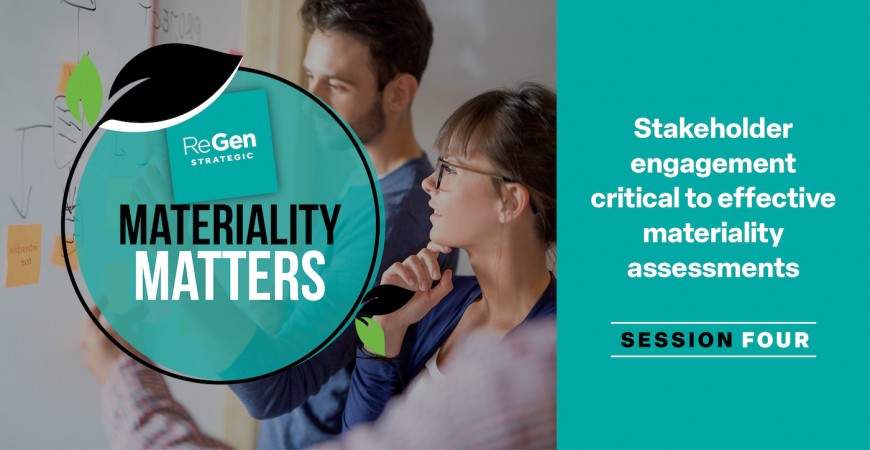I’ve lost count of the number of times I have read a sustainability report and come across a materiality assessment that appears not to have engaged with stakeholders.
Yes, the views and priorities of stakeholders appear to have been considered. But, these appear to have been based on assumptions or the outcomes of previous engagement, which may have been undertaken for a different purpose.
Engaging with stakeholders for materiality assessment
As someone who runs a business with practices in both sustainability and stakeholder engagement, you might not be surprised to learn that I think this is short-sighted. But, organisations that miss the opportunity to engage with their stakeholders in undertaking a materiality assessment and developing a sustainability strategy are undermining themselves in two ways.
First, they are guessing on the topics that might be material to their stakeholders, and may miss the most recent movements in sentiment or emerging issues. Conducting a materiality assessment without robust stakeholder engagement is akin to sailing without a compass – it leaves businesses adrift, unsure of their direction and vulnerable to unforeseen challenges.
Stakeholder engagement is not merely a box to check; it’s the cornerstone upon which successful materiality assessments are built. Without engaging with stakeholders – both internal and external – organisations risk missing vital insights into what truly matters to those affected by their operations.
By involving stakeholders from the outset, businesses ensure that the material topics identified align closely with stakeholder needs and expectations. This alignment is key to minimising risk and maximising opportunities, as it allows organisations to proactively address the issues that are of greatest concern to their stakeholders.
Second, with more and more of organisational value consisting of intangibles like reputation and the quality of stakeholder relationships, performing a materiality assessment without stakeholder engagement misses an opportunity to build trust and deepen relationships.
Engaging with stakeholders for deeper relationships
Stakeholder engagement performed through a materiality assessment helps maintain positive stakeholder relationships by demonstrating a commitment to listening and responding to stakeholder concerns. By engaging with communities and building trust, organisations secure the social licence to operate – a crucial asset in today's socially and environmentally conscious landscape. Moreover, robust engaging with stakeholder provides assurance that the process has been conducted effectively, especially when external validation is sought. This transparency helps mitigate the risk of greenwashing and avoids unwanted stakeholder criticism or scrutiny.
Employee satisfaction is another significant outcome of robust stakeholder engagement. By involving employees in the sustainability journey and considering their opinions, organisations foster a sense of ownership and engagement amongst their workforce. Employees who feel heard and valued are more likely to embrace sustainability initiatives and contribute to their success.
Stakeholder engagement in a materiality assessment process is not unlike stakeholder engagement, more broadly. Mapping and prioritising stakeholders is undertaken based on a stakeholder’s influence and interest levels, as they relate to an organisation’s purpose.
Engagement is then undertaken in a way that suits individual stakeholders, whether through surveys, interviews, workshops, or other techniques. There is no one-size-fits-all solution to stakeholder engagement, and organisations must be flexible in their approach to ensure meaningful participation.
Providing sufficient context and background to stakeholders is equally important. Clearly communicating their role in the materiality assessment process helps stakeholders understand the significance of their input. Descriptions of topics, examples of risks and opportunities, and other relevant information provide stakeholders with the necessary context to make informed contributions. This transparency not only improves the quality of outcomes but also fosters trust and goodwill among stakeholders.
Conclusion
In conclusion, stakeholder engagement is not just a checkbox – it's the bedrock of effective materiality assessments and sustainability strategies. By engaging with stakeholders throughout the assessment process, organisations can identify material topics that align closely with stakeholder needs and expectations, minimising risk and maximising opportunities. Moreover, robust stakeholder engagement fosters positive relationships, builds trust and contributes to a social licence to operate.
If you want a sustainability strategy that creates business value and maximises sustainability impact, don’t cut corners at the front end. Investing in stakeholder engagement as a part of the materiality assessment process will set your sustainability strategy, as well as your organisation, up for success.
 ReGen Strategic
ReGen Strategic